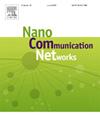Beyond 5G: Exploring key enabling technologies, use cases, and future prospects of 6 G communication
IF 4.7
4区 计算机科学
Q2 ENGINEERING, ELECTRICAL & ELECTRONIC
引用次数: 0
Abstract
As the world continues to embrace digital transformation, there is a growing need for even more advanced communication technologies to meet the demands of massive connectivity, huge data rates, and low latency requirements. 6 G is the next frontier in wireless communication. This technology explores breakthroughs in different fields, such as terahertz communication, massive multiple-input multiple-output (MIMO), and even quantum communication. This review paper explains the advancements, Challenges, and future directions in the 6 G wireless communication networks. Furthermore, this paper discusses the challenges and opportunities in realizing the vision of 6 G communication, ranging from spectrum allocation and hardware design to security and ethical considerations. The key technologies, such as visible light communications, holographic messaging, and concepts on subterahertz frequencies are explained briefly. This paper also deals with practical considerations such as heterogeneous multi-layer mobile edge computing, intelligent vehicular networks, and deep learning communication systems. Furthermore, fundamental concepts such as massive MIMO and spatial division of multiple access are analyzed. The key enabling technologies that shape the 6 G use cases and their challenges are also discussed. Finally, this paper concludes by outlining the potential candidate technologies for future research and innovation, emphasizing the importance of collaborative efforts to realize the transformative potential of 6 G technology.

超越5G:探索6g通信的关键使能技术、用例和未来前景
随着世界继续拥抱数字化转型,越来越需要更先进的通信技术来满足大规模连接、高数据速率和低延迟要求的需求。6g是无线通信的下一个前沿。这项技术探索了不同领域的突破,例如太赫兹通信,大规模多输入多输出(MIMO),甚至量子通信。本文介绍了6g无线通信网络的进展、挑战和未来发展方向。此外,本文还讨论了实现6g通信愿景的挑战和机遇,从频谱分配和硬件设计到安全和伦理考虑。简要说明了关键技术,如可见光通信、全息信息和亚太赫兹频率的概念。本文还讨论了异构多层移动边缘计算、智能车联网和深度学习通信系统等实际考虑。在此基础上,分析了大规模MIMO和多址空间划分等基本概念。本文还讨论了塑造6g用例的关键使能技术及其面临的挑战。最后,本文概述了未来研究和创新的潜在候选技术,强调了协作努力实现6g技术变革潜力的重要性。
本文章由计算机程序翻译,如有差异,请以英文原文为准。
求助全文
约1分钟内获得全文
求助全文
来源期刊

Nano Communication Networks
Mathematics-Applied Mathematics
CiteScore
6.00
自引率
6.90%
发文量
14
期刊介绍:
The Nano Communication Networks Journal is an international, archival and multi-disciplinary journal providing a publication vehicle for complete coverage of all topics of interest to those involved in all aspects of nanoscale communication and networking. Theoretical research contributions presenting new techniques, concepts or analyses; applied contributions reporting on experiences and experiments; and tutorial and survey manuscripts are published.
Nano Communication Networks is a part of the COMNET (Computer Networks) family of journals within Elsevier. The family of journals covers all aspects of networking except nanonetworking, which is the scope of this journal.
 求助内容:
求助内容: 应助结果提醒方式:
应助结果提醒方式:


